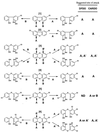Degradation of chlorinated dibenzofurans and dibenzo-p-dioxins by two types of bacteria having angular dioxygenases with different features
- PMID: 11472938
- PMCID: PMC93062
- DOI: 10.1128/AEM.67.8.3610-3617.2001
Degradation of chlorinated dibenzofurans and dibenzo-p-dioxins by two types of bacteria having angular dioxygenases with different features
Abstract
Two kinds of bacteria having different-structured angular dioxygenases-a dibenzofuran (DF)-utilizing bacterium, Terrabacter sp. strain DBF63, and a carbazole (CAR)-utilizing bacterium, Pseudomonas sp. strain CA10-were investigated for their ability to degrade some chlorinated dibenzofurans (CDFs) and chlorinated dibenzo-p-dioxins (CDDs) (or, together, CDF/Ds) using either wild-type strains or recombinant Escherichia coli strains. First, it was shown that CAR 1,9a-dioxygenase (CARDO) catalyzed angular dioxygenation of all mono- to triCDF/Ds investigated in this study, but DF 4,4a-dioxygenase (DFDO) did not degrade 2,7-diCDD. Secondly, degradation of CDF/Ds by the sets of three enzymes (angular dioxygenase, extradiol dioxygenase, and meta-cleavage compound hydrolase) was examined, showing that these enzymes in both strains were able to convert 2-CDF to 5-chlorosalicylic acid but not other tested substrates to the corresponding chlorosalicylic acid (CSA) or chlorocatechol (CC). Finally, we tested the potential of both wild-type strains for cooxidation of CDF/Ds and demonstrated that both strains degraded 2-CDF, 2-CDD, and 2,3-diCDD to the corresponding CSA and CC. We investigated the sites for the attack of angular dioxygenases in each CDF/D congener, suggesting the possibility that the angular dioxygenation of 2-CDF, 2-CDD, 2,3-diCDD, and 1,2,3-triCDD (10 ppm each) by both DFDO and CARDO occurred mainly on the nonsubstituted aromatic nuclei.
Figures


Similar articles
-
Isolation and characterization of the genes encoding a novel oxygenase component of angular dioxygenase from the gram-positive dibenzofuran-degrader Terrabacter sp. strain DBF63.Biochem Biophys Res Commun. 2001 Apr 27;283(1):195-204. doi: 10.1006/bbrc.2001.4763. Biochem Biophys Res Commun. 2001. PMID: 11322788
-
Dehalogenation, denitration, dehydroxylation, and angular attack on substituted biphenyls and related compounds by a biphenyl dioxygenase.J Bacteriol. 2001 Jun;183(12):3548-55. doi: 10.1128/JB.183.12.3548-3555.2001. J Bacteriol. 2001. PMID: 11371517 Free PMC article.
-
Preliminary examinations for applying a carbazole-degrader, Pseudomonas sp. strain CA10, to dioxin-contaminated soil remediation.Appl Microbiol Biotechnol. 2001 Sep;56(5-6):788-95. doi: 10.1007/s002530100707. Appl Microbiol Biotechnol. 2001. PMID: 11601631
-
Microbial degradation of chlorinated dioxins.Chemosphere. 2008 Apr;71(6):1005-18. doi: 10.1016/j.chemosphere.2007.10.039. Epub 2008 Feb 20. Chemosphere. 2008. PMID: 18083210 Review.
-
Bacterial metabolism of fluorene, dibenzofuran, dibenzothiophene, and carbazole.Can J Microbiol. 2000 May;46(5):397-409. Can J Microbiol. 2000. PMID: 10872075 Review.
Cited by
-
A Review of Soil Contaminated with Dioxins and Biodegradation Technologies: Current Status and Future Prospects.Toxics. 2022 May 24;10(6):278. doi: 10.3390/toxics10060278. Toxics. 2022. PMID: 35736887 Free PMC article. Review.
-
Biostimulation potentials of corn steep liquor in enhanced hydrocarbon degradation in chronically polluted soil.3 Biotech. 2019 Feb;9(2):46. doi: 10.1007/s13205-019-1580-4. Epub 2019 Jan 23. 3 Biotech. 2019. PMID: 30729070 Free PMC article.
-
Bacterial degradation of aromatic compounds.Int J Environ Res Public Health. 2009 Jan;6(1):278-309. doi: 10.3390/ijerph6010278. Epub 2009 Jan 13. Int J Environ Res Public Health. 2009. PMID: 19440284 Free PMC article. Review.
-
Degradation of mono-chlorinated dibenzo-p-dioxins by Janibacter sp. strain YA isolated from river sediment.Curr Microbiol. 2005 Nov;51(5):353-8. doi: 10.1007/s00284-005-0099-6. Epub 2005 Oct 15. Curr Microbiol. 2005. PMID: 16235020
-
Carbazole degradation in the soil microcosm by tropical bacterial strains.Braz J Microbiol. 2015 Oct-Dec;46(4):1037-44. doi: 10.1590/S1517-838246420140610. Epub 2015 Oct 27. Braz J Microbiol. 2015. PMID: 26691461 Free PMC article.
References
-
- Armengaud J, Timmis K N. Molecular characterization of Fdx1, a putidaredoxin-type [2Fe-2S] ferredoxin able to transfer electrons to the dioxin dioxygenase system of Sphingomonas sp. RW1. Eur J Biochem. 1997;247:833–842. - PubMed
-
- Armengaud J, Timmis K N. The reductase RedA2 of the multicomponent dioxin dioxygenase system of Sphingomonas sp. RW1 is related to class-I cytochrome P450-type reductases. Eur J Biochem. 1998;253:437–444. - PubMed
MeSH terms
Substances
LinkOut - more resources
Full Text Sources
Other Literature Sources
Miscellaneous

